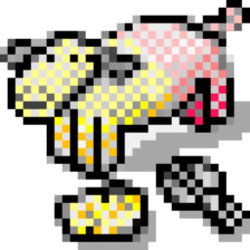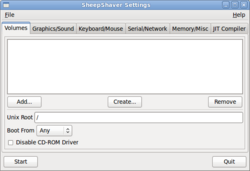Software:SheepShaver
 | |
| Developer(s) | Christian Bauer, Gwenole Beauchesne |
|---|---|
| Initial release | 1998 |
| Final release | 2.5
/ September 13, 2022 |
| Preview release | 2.5
|
| Operating system | BeOS, Linux, Mac OS X, Windows |
| Type | Emulator |
| License | GPL |
| Website | {{{1}}} |
SheepShaver is an open-source PowerPC Apple Macintosh emulator originally designed for BeOS and Linux. The name is a play on ShapeShifter,[1] a Macintosh II emulator for AmigaOS (made obsolete by Basilisk II). The ShapeShifter and SheepShaver projects were originally conceived and programmed by Christian Bauer. However, currently, the main developer is Gwenolé Beauchesne.
History
SheepShaver was originally commercial software when first released in 1998, but after the demise of Be Inc., the maker of BeOS, it became open source in 2002.[1] It can be run on both PowerPC and x86 systems; however, it runs more slowly on an x86 system than on a PowerPC system, because of the translation between the PowerPC and Intel x86 instruction sets.[2] SheepShaver has also been ported to Microsoft Windows. [citation needed]
As a free software, a few variants exist to simplify the installation process on Intel-based Macs:
- ‘Sheep Shaver Wrapper’[3] is built off of Sheep Shaver but it does some of the bundling work for the user.
- 'Chubby Bunny'[4] also simplifies the set up process of OS 9 visualization on Intel Macs running OS X.
Features
SheepShaver is capable of running Mac OS 7.5.2 through 9.0.4[1] (though it needs the image of an Old World ROM to run Mac OS 8.1 or below[5]), and can be run inside a window so that the user can run classic Mac OS and either BeOS, Intel-based Mac OS X, Linux, or Windows applications at the same time.
Although SheepShaver does have Ethernet support and CD-quality sound output,[1] it does not emulate the memory management unit.[2] While adding MMU emulation has been discussed, the feature has not been added because of the effort required in implementing it, the impact on performance it will have and the lack of time on the part of the developers.
See also
- PearPC
- vMac
- Basilisk II
- Classic Environment
- Executor
References
- ↑ Jump up to: 1.0 1.1 1.2 1.3 "The Official SheepShaver Homepage". http://sheepshaver.cebix.net/. Retrieved 15 December 2012.
- ↑ Jump up to: 2.0 2.1 "SheepShaver". Archived from the original on March 1, 2009. https://web.archive.org/web/20090301045736/http://gwenole.beauchesne.info/en/projects/sheepshaver. Retrieved 16 December 2012.
- ↑ "The SheepShaver Wrapper for OS X". http://www.columbia.edu/~em36/sheepshaverwrapper.html. Retrieved 11 February 2014.
- ↑ "Another Solution for the Appleworks Conundrum-it's called Chubby Bunny". 28 September 2013. http://macvalley.blogspot.com/2013/09/another-solution-for-appleworks.html. Retrieved 11 February 2014.
- ↑ "Setting up SheepShaver for Windows". http://www.emaculation.com/doku.php/sheepshaver_setup#introduction. Retrieved 15 December 2012.
External links
- SheepShaver for x86 (in Japanese)
- E-Maculation forum on SheepShaver
- SheepShaver for Windows setup guide
- SheepShaver for OSX setup guide
- Gwenole Beauchesne's SheepShaver page (archived)
 |



